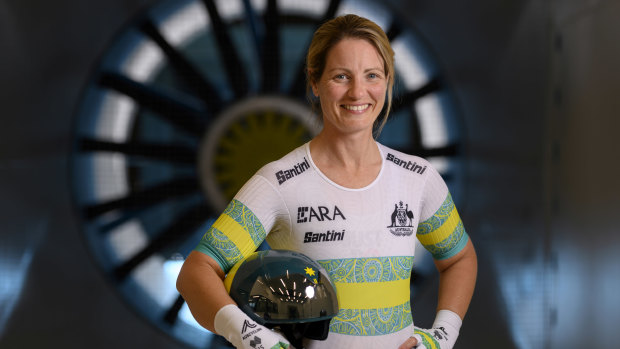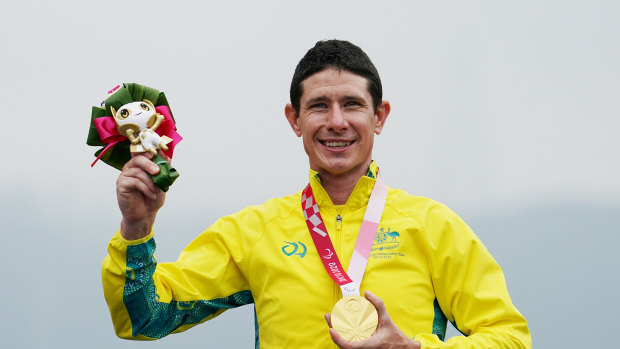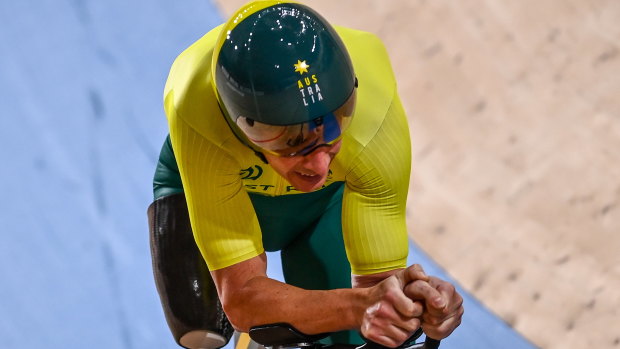
Using highly sophisticated instruments and computer software, coaches and aerodynamicists can then analyse how body positions, clothing, helmets and bikes can cause drag and make alterations to posture or equipment.
Petricola was able to analyse the impact that her weaker left side was having on her performance and adjust her position on the bike.

Emily Petricola in front of the wind tunnel.Credit: Ben Searcy
“I was favouring my right side and having to move my body just to get my left leg around,” she says.
“The difference in the position means I’m not rocking around as much, I’m a bit more stable on the bike and therefore more aerodynamic. People who have seen me riding since we’ve made the adjustments have said you can see a big difference now.”
Darren Hicks – whose right leg was amputated above the knee after a road crash in 2014 – thought his first coach, Loz Shaw, was crazy when he suggested stopping using a prosthetic and instead race pedalling with just his left leg.
But the suggestion – which put Hicks in a different disability class – was inspired. At the Tokyo Paralympics, Hicks won the gold medal in the men’s C2 road time trial and silver in the men’s C2 3000m individual pursuit.

Darren Hicks on the podium after his gold medal in the time trial at the Tokyo Paralympics.Credit: Getty Images
“I’m very glad that Loza had the mindset he did. To challenge me and challenge the norm, which in my situation probably would have been to ride with a prosthetic,” Hicks says.
“He just saw the bigger picture, which is always the way he’s been inclined, which is pretty incredible.
“But riding with one leg is tough. It takes a far bigger toll on your calf, your quad and your hamstring – they’re working overtime because they’re doing the work of two legs.
“The biggest thing that took a couple of years to work out, is that I actually use my arms and my shoulders a lot more than I would have anticipated.”

Darren Hicks.Credit: Getty Images
After training in the wind tunnel, Hicks tweaked a few things with the bracket and “bucket” which attaches to the frame of the bike and holds his stump in place.
“The changes have helped bring my shoulders and head further down which has put me in a better aero position,” he says.
Loading
He said the wind tunnel was an extremely efficient way of experimenting with small tweaks that improved performance. “The results from a change can be seen so quickly, within a minute of finishing the test you can download the data. We’re very lucky to have it.”
Wind tunnels were invented in the late 1800s and were used by the Wright brothers – who invented the first plane that could be controlled by a pilot – to study the effects of airflow over various shapes.
Sporting equipment has also been studied in wind tunnels, including golf clubs, golf balls, bobsleds, and race car helmets.
A wind tunnel was also used by the German sailing team ahead of the Rio Olympic Games in 2016, where it enabled each athlete to analyse individual elements which, when applied, could make all the difference in competition.
Loading
The South Australian Sports Institute’s John Pitman said Australian athletes had trained in wind tunnels at Silverstone in the UK and Monash University before the state-of-the-art facility was finished in Adelaide in February this year.
He said all the Australian Olympic and Paralympic cyclists who had used the wind tunnel over the last three or four weeks had seen very useful performance gains.
“So those people who have had those opportunities and gained those insights are certainly going to be going faster than they otherwise would have done,” Pitman said.
“It’s something you’ve got to do to be competitive. Other places in the world are working on this sort of thing, so this makes sure that they have got all the required preparation elements.”



























